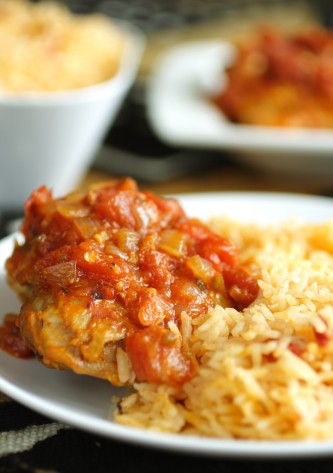Joloff Rice—Fancy Style

The Indians have turmeric, the Europeans, beets, and the Africans, palm oil—an intensely colored oil extracted from the fruits of the oil palm that adds a shot of deep orange-red color to whatever food it touches, including this popular West African pilaf-style dish. If you not have palm oil, you may use vegetable oil; the dish will still have a red tinge from the tomatoes, though it will miss the distinctive flavor palm oil provides. (Many food writers describe palm oil as being overpoweringly oily for Western tastes; used in this quantity, I did not find it to be so.)
The second flavor magnifier in this dish is ground dried shrimp or crayfish, which acts as deliciously bold seasoning (notice, no salt is used in this recipe) and provides, in combination with the chicken, a satisfying range of tastes singular to land and sea-based rice dishes (think Jambalaya).

Dried crayfish and liquified palm oil
In this version of Joloff Rice from 70 Traditional African Recipes the rice is cooked separately and chicken cooking liquid is reduced to a thick, chunky sauce before being poured over the cooked chicken pieces. Typically, this dish is cooked in one pot, rice and all. (Joloff Rice is thought to originate with the Wolof people of Senegal and Gambia; in the Wolof language, it is also called benachin, meaning “one pot.”) Perhaps Rosamund Grant, the author of 70 Traditional African Recipes, wanted more liquid-to-rice ratio control when cooking her rice or perhaps she simply wanted to upscale this traditional one-pot dish.*
I will be making Joloff Rice for the DCCC African potluck this Sunday, but as a one-pot meal. If I successfully deconstruct Grant’s three-step version back to a one-pot recipe, I’ll share the results.
*Later the same night that I posted this story, I learned that Joloff Rice is sometimes made the way Grant makes it her recipe. See the posting “What Are the Chances?”.
Joloff Chicken and Rice
Recipe from 70 Traditional African Recipes by Rosamund Grant
Serves 4
2¼ pounds bone-in chicken pieces
2 garlic cloves, minced
1 teaspoon dried thyme leaves
2 tablespoons palm or vegetable oil (see Note)
1 onion, chopped
One 14-ounce can diced tomatoes, with juice
1 tablespoon tomato paste
2 cups chicken stock
2 tablespoons dried shrimp or crayfish, finely ground in a mortar and pestle, or 2 teaspoons shrimp or crayfish powder (see Note)
1 green chili pepper, seeded and finely chopped
1½ cups long-grain rice, washed in several changes of water and drained
- Rub the chicken pieces with the garlic and thyme and set aside.
- Heat the oil in a large Dutch oven, braiser, or other large pot, preferably wide enough to brown all the chicken pieces at once, until hot but not smoking. Brown the chicken pieces on all sides, then add the onion, diced tomatoes, and tomato paste. Cook over moderately high heat for about 5 minutes, stirring occasionally.
- Add the stock to the pan and stir well. Bring to a boil, then reduce the heat, cover the pan, and simmer for about 40 minutes.
- Add the ground shrimp or crayfish and the chili pepper. Simmer for an additional 5 minutes, stirring occasionally.
- Put the rice in medium-size heavy bottomed saucepan. Scoop 1¼ cups of the sauce into a 2-cup measure, top with water to 2 cups, and add to the rice. Cook over medium heat to partially absorb the water—until the water is about level with or just below the surface of the rice. Place a round piece of foil—cut to the size of the pan’s lid—on top of the rice, cover, and cook over low heat for 10 minutes, adding a little more water if necessary. Let sit covered for about 5 minutes.
- Transfer the chicken pieces to a serving platter. Simmer the sauce until reduced by half. Pour the thickened sauce over the chicken and serve with the rice.
Note: Palm oil and dried shrimp or crayfish are available in most Asian, African, or Caribbean food shops. I ordered African ingredients online at Aboasa International Market. Palm oil solidifies at room temperature, but liquefies when heated.
Recipe reprinted from 70 Traditional African Recipes (ISBN: 978-1-84476-966-7) with the express permission of Southwater. Recipe introduction was written by Holly Jennings.
